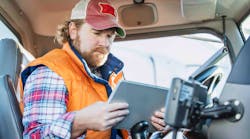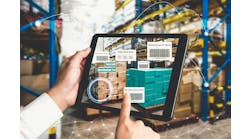Truck drivers have challenging jobs. They must drive for many consecutive hours, with constant concentration and vigilance. When the truck driver arrives at their destination, they must check in to the yard or dock and then load and unload cargo. Getting out of the truck can put truck drivers in danger. Many workplace injuries occur when drivers load or unload cargo, secure freight, walk around the truck yard, or wait at a customer location.
According to the US Bureau of Labor Statistics, nearly 30% of workplace injuries in the trucking industry are from drivers slipping or falling on the job. Stepping out of a truck is dangerous because the step can be slippery, and the driver can easily fall. A typical cab height is four feet from the ground—a very high step for most people.
Many truck accidents happen in truck stops, rest centers, parking lots, and truck yards. If the driver is out of the cab, they can be struck by falling objects or hit by another vehicle.
A truck must connect with the dock when it backs up to a loading dock. Premature separation of the trailer can result in serious accidents. Drivers need to remember to set the brakes or use wheel chocks. The cargo in the trailer may shift during transport, which can make the load unsteady. Drivers may or may not be responsible for inspecting products to ensure they have been correctly loaded and secured.
While these safety concerns are part of the job, minimizing the times a driver exits the cab is an important aspect of driver safety.
What is a Check-In/Check-Out Kiosk?
Modern kiosk check-in/check-out applications can be an important part of a safety program by keeping drivers and employees away from hazards. They also can greatly improve site operations and carrier relationships when used as part of a comprehensive tendering, scheduling and loading workflow, by increasing predictability of time on-site and rewarding scheduling compliance.
Kiosks traditionally have been free-standing booths housing personal computer components to perform dedicated functions. These kiosks often have a computer screen or touchscreen interface that allows users to interact with the system and access the information or services they need. They may also have hardware components such as printers, card readers, scanners and cameras to facilitate transactions and other interactions.
Modern kiosks utilize mobile applications loaded on standard tablets or mobile phones, providing a more cost-effective solution with more efficient mounting options for use from within the cab. Some of these apps even allow the same check-in process to be performed directly on a drivers’ cell phone. These kiosk apps can also integrate with customer systems using application programming interfaces (APIs) to streamline communications and get drivers loaded more quickly.
Many kiosks also contain step-by-step instructions and are available in multiple languages. The instructions are simple, making the kiosk easier to use, especially for tech-averse individuals. A truck driver picking up or delivering a shipment at a facility can directly key in the required information into the kiosk instead of walking into the yard, customer service office, or gatehouse.
How Does a Kiosk Work?
A kiosk helps truck drivers to check in, receive delivery instructions, retrieve goods, and obtain delivery documents, streamlining the delivery process, reducing errors, and improving efficiency for truck drivers and shippers. Typically, a kiosk offers:
Check-in: A truck driver can check in using a touchscreen interface when they arrive at the kiosk. The driver is prompted to enter their shipment information, such as the order number or address.
Instructions: Once the driver has checked in, the kiosk may provide them with instructions on where to park, how to load the goods and other details. This information may be displayed on the screen, or the driver may receive a printed receipt or ticket.
Goods retrieval: In some cases, the kiosk may communicate driver arrival to material handling personnel (or directly interface to equipment) to start the staging process.
Delivery documents: The kiosk may also print out delivery documents, such as bills of lading or delivery receipts, that the driver can use to confirm the correct product is being shipped.
Confirmation: Once the process is complete, the driver can confirm this on the kiosk, which may prompt them to rate the experience or provide feedback.
Keeping Truck Drivers Safe
Using a kiosk can help keep truck drivers in their trucks, improving their safety and speeding check-ins for quicker loading/unloading.
Without a kiosk, the guard in a guard shack must validate (usually through a manual process) whether a particular truck should be on the property. Guards need to validate that the driver is with the right company and has the proper load information to allow check-in. A check-in process using a kiosk provides a self-service experience for the driver, speeding the process and enforcing consistency through systemic controls.
A kiosk allows carriers using a mobile app to check in for appointments at a facility directly from the cab without getting out of the truck. Truck drivers can review data agreements, safety requirements and other information the shipper requires. Once reviewed and approved, drivers can provide an e-signature and quickly check in to announce they are at the site and ready to be loaded.
Use of a kiosk application also allows other technologies such as text messaging, push notifications and GPS validation to enhance the process. For instance, a check-in process in a driver app can automatically start when the driver arrives on-site and prevent check-in from their device until they are on-site.
Other key components of a kiosk app include:
· Gate agreements with pictorial instructions, such as required personal protective equipment (PPE).
· Integration with scheduling and warehouse management systems to integrate appointment information into the workflow and perform validations and cross-checks.
· Specific instructions to the driver, including where they are in line and instructions based on early/late arrival.
· Integration with industrial signage to keep drivers informed of their status as they are waiting and to provide movement instructions when ready to load.
· Multi-language capability to support an increasingly diverse workforce, including language-specific text messaging based on driver preference.
· Digital signature capture to support compliance initiatives.
· Facility maps showing routes to loading areas, rail crossings, and other instructions.
· A check-out process that includes bill of lading details and quantity verification.
Integrating the kiosk functions with a transportation management system or ERP system creates a closed-loop process, facilitating transportation management and load tracking. Once the truck driver signs out that they are leaving the yard on the kiosk, the load can be tracked while in transit. An estimated time of arrival can be sent to the destination. The ERP system can be triggered to print a bill of lading at the exit point of the yard. Hence, the carrier gets the paperwork automatically, and systems are updated.
It Pays to be Safe
The National Council on Compensation Insurance’s (NCCI) Workers Compensation Statistical Plan database says that the average cost of a slip or fall accident is over $48,000, and that doesn’t account for the cost of litigation. More serious injuries can cost even more, and none of this accounts for the damage to a company’s reputation in the media or with other truckers. Using technology like kiosks, companies can reduce the risk of injury to truckers, improve the productivity of their teams, move shipments faster, control costs, and deliver a better experience for everyone involved.
Use of kiosks can be an important part of a company’s safety program and culture. Reducing the need for drivers and employees to enter areas with hazards not only has a direct safety impact, but also promotes a safety-centered mindset that sets the right tone for both employees and carrier partners. When used as part of a comprehensive tendering, scheduling and loading workflow focused on safety and efficiency for both the shipper and carrier, improved relationships are a result.
Brian Flint is global director of product management with IntelliTrans, a provider of global multimodal solutions for optimizing supply chain operations for bulk & break-bulk industries.



